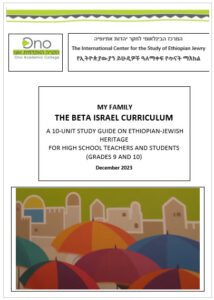MY FAMILY
THE BETA ISRAEL CURRICULUM

HISTORY I: 1270-1632
Teachers should remind students a few points from Unit 1, including The fact that while many people regard the Beta Israel as being the descendants of the lost Tribe of Dan, who lived in Ethiopia for over 2,500 years, alternative theories suggest that the Beta Israel have slightly later origins.21
It should be emphasized that none of the sources on Ethiopian Jews from the period between the sixth and thirteenth centuries are of sufficient historicity to permit anything more than the most tentative of conclusions,22 which means that most recorded history of the Beta Israel begins only in 1270.
Having explained this, the teacher should give students the following four excerpts to read, after which teachers should as a series of questions to review comprehension and understanding
| TEXT 1: From Sinai to Ethiopia, pp. 31-32 By Rabbi Dr. Sharon Shalom |
| Ethiopia is one of the most ancient Christian countries in the world. King Ezana of Ethiopia was one of the earliest rulers to convert to Christianity, in 333 CE, preceded only by the conversion of the ruler of Armenia in 301 CE and the conversion of the Roman emperor Constantine in 312 CE… In traditional Ethiopia, only two institutions have tried to define and lead the daily life of the population on a national basis, and only they had the ability to do so. These were the emperor and the Ethiopian church, which he headed. …In the ancient chronicles… we read with bated breath of the cruel wars against the [Beta Israel]… who denied the basic principles of Christianity. These wars continued for almost five hundred years. Their enemies had to admit that the Beta Israel defended themselves heroically against their persecutors. Unintentionally, the authors of the chronicles express amazement and admiration at the courage of the men, women, and children who chose martyrdom over conversion. |
| TEXT 2: From Sinai to Ethiopia, p. 63 By Rabbi Dr. Sharon Shalom |
| [The period between] 1270–1632 [was one of]…anti-Semitic persecution. Heavy pressure [was] placed on “those behaving like Jews” for them to convert or be killed. In response, the Jews adopt ascetic practices of their neighbors. In addition, the rights of Jewish landowners are annulled. The Jews who are expelled from their lands are forced to change their trades, and they become builders, ironworkers, carpenters, and weavers. Following the expulsion, they are given the derogatory name Falasha, meaning “intruders” or “foreigners.” |
| TEXT 3: “Art as Experience: The Religious Culture of Ethiopian Jewry”23 The Monk and the Lion: Contemporary Ethiopian Visual Art in Israel By Rabbi Dr. Sharon Shalom |
| Beta Israel’s specialization in crafts – ceramics, weaving and masonry – was the result of the prohibition on land ownership imposed by the Christian emperor Yeshak (1413-1430). This prohibition forced the Jews of Beta Israel to change careers, from real estate and agriculture to mobile professions such as carpentry, ceramics, and ironwork. As noted by Kaplan, “According to the sources, Yeshak told the Beta Israel that he who is baptized in the Christian religion may inherit the land of his father, otherwise let him be a Falasi… There is virtual consensus that the kingdom of Yeshak marks the beginning of the long term policy of stripping Beta Israel of its land.”… Many of the Beta Israel community reconciled themselves to the new circumstances and traded their material assets for those that could enhance their earning capacity such as pottery, blacksmithing, and weaving. There is no doubt that this move, which transformed the world and livelihood of the Beta Israel, contributed in no small measure to the economic survival of the community. |
| TEXT 4: “A History of Beta Israel”24 By Steven Kaplan |
| The “institution of monasticism was developed as a means of revitalizing the moral and ideological basis of their society after their defeat by Yeshaq.” |
| TEXT 5: From Sinai to Ethiopia, p. 264 By Rabbi Dr. Sharon Shalom |
| We must preserve the uniqueness of the Jewish people. The Ethiopian Jews demonstrated loyalty to the Jewish people despite many trials and a long period of exile. Through this extreme practice, the community was able to preserve its uniqueness and avoided [excess] mingling with the Christian neighbors. |
Having read these texts, teachers should ask their students the following questions, for reflection and discussion:
- Imagine you were a member of the Beta Israel living during these periods of religious persecution and forced conversions. Given the fact that being Jewish meant you were forbidden from owning land, why would you choose to remain true to your faith? – Teachers may wish to remind students of Ethiopian Jewry’s strong dedication to Zionism, as core to its Jewish faith. Specifically, recall the community’s preference to be called by the Hebrew name, Beta Israel (House of Israel), rather than by the pejorative Falasha (“exiled”). The name Beta Israel underscores the community’s belief in descent from the Tribe of Dan and serves as a symbolic proclamation of its refusal to convert to Christianity; even amid oppression, the Beta Israel would not forsake its Israelite heritage.
- What do you think life was like for the Beta Israel, living on land they could never own?
- How did entering the professions of carpentry, ceramics, and ironwork help the Beta Israel? – Teachers and students may wish to reflect here on the famines in Ethiopia, and the hardships these crises placed on the economic survival of the Beta Israel. Discussion can focus on how these professions allowed the Beta Israel to manufacture essential products needed for the construction and maintenance of cities, with the added benefit of mobility, i.e., traveling to busy marketplaces to sell these goods.
- What do you think it means that the Beta Israel adopted “ascetic practices” and “monasticism” in response to the pressure to convert – Teachers can explain that these terms reflect the Beta Israel’s practice of establishing clear social and physical boundaries between themselves and Christians. Teachers should point out that the Jewish villages in Ethiopia were also located near sources of flowing water, which enabled the community to observe Jewish laws of purity. This practice was important for maintaining distinction25 from Christians.
- Based on the Ethiopian Jewish experience that you’ve learned so far, what do you think was the Beta Israel’s attitude toward intermarriage? What are your thoughts about intermarriage? – Teachers and students should discuss this topic with extreme sensitivity. It should also be noted the Beta Israel’s commitment to its Jewish faith and opposition to intermarriage was one of the main reasons that the State of Israel accepted them as Jewish. To quote Rabbi Sharon Shalom, From Sinai to Ethiopia, p. 264, this is one the reasons, “we must work to eliminate the phenomenon of intermarriage between Jews and non-Jews.26
21 See Unit 1: The Twelve Tribes, based on Rabbi Sharon Shalom, From Sinai to Ethiopia, pp. 61-62.
22 Steven Kaplan, “A History of Beta Israel,” in addendum to Michael Corinaldi, Jewish Identity: The Case of Ethiopian Jewry, (Magnes Press, 1998), p. 160.
23 Rabbi Dr. Sharon Shalom, “Art as Experience: The Religious Culture of Ethiopian Jewry,” in The Monk and the Lion: Contemporary Ethiopian Visual Art in Israel (ed. Dekel, E. Yerday, E. Wexler, S. Keshet), (Achoti Publications, 2017), p. 21.
24 Addendum to Corinaldi, Jewish Identity: The Case of Ethiopian Jewry, p. 166.
25 Shalom, From Sinai to Ethiopia, 211.
26 Ibid







